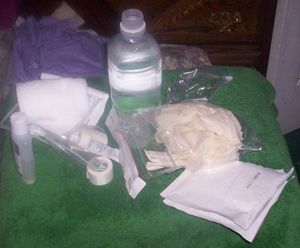When my Mom had major surgery on April 8th 2008, we knew some complications could occur but weren’t prepared when they did happen. She went into surgery to have a volley ball size mass removed from her ovary and also had a complete hysterically at 47 years old. My Mom is also diabetic so there was some concern there but this surgery had to be done as the mass kept growing and was painful.
When someone has a mass on their ovary and has surgery, doctors usually go in vaginally if the mass is small. My Mom did not have that option because the mass was so large. Her doctor originally thought it was cantaloupe sized but when it was removed it was much larger then that. She had to have a large cut on her stomach so the doctor could remove it. My Mother is a plus size woman so cutting into her meant going deeper and through fat cells. She went through her surgery OK and they let her come home five days after surgery. She had a long angry looking stapled wound on her stomach that started looking discolored a couple of days after being home.
My Mom went to the doctor a week later and they removed the staples. Stuff started oozing out and the wound opened up on her stomach. This really scared her and the entire family. We had never heard of this happening before. The doctor told us that this is actually common. That did NOT make us feel better but at least we knew it wasn’t this freak rare occurrence. The wound was about the length of your index finger length wise. The doctor put padding in the wound and said it had to be changed once a day. He said that he’d try to get a home nurse to come out but in the meantime it’d have to be changed by family members.
My Mom was having a hard time keeping calm during the changing of her wound and I don’t blame her. If I had a large creepy looking hole in my stomach, I’d be freaking out too. The first time I saw the open wound, I felt hot and had to sit down. I didn’t show my distress though because I didn’t want my Mom to be upset further. But seeing that open wound on my Mom got to me, it really did. As time went on, I got slightly more used to it. Cleaning it was something that had to be done and I was determined to act normally and do the job right.
Two days after my Mom went to the doctor, a home nurse came. Her job was to show me how to properly clean the wound so that I would do it myself. She said she would come once a week to measure the wound and see how it’s doing. The nurse also told us that because my Mom is diabetic the wound will take longer to heal. The doctors do not re-stitch the wound; the skin fills in the hole over time until it’s closed. It’s only been a month since my Mom has had surgery and though the wound still looks a little creepy (best word I can use for it), it is getting better slowly but surely.
If you find yourself in this same situation, first take a deep breath. This is a stressful situation for both the person who has the wound and for you, the one who is changing it. If the person who had surgery is insured, the insurance should cover the cost of a home nurse coming once a week and supplies. The nurse should show you what to do but in our case, the nurse didn’t even come until we had been changing it on our own so this article should help prepare you. These directions are how they were exactly shown to me by the home nurse.
To change the wound, first wash your hands. Have the person lay down on a bed or other flat area. If you have a tray, set it up and put a clean towel on top of it. Now get all your supplies set up and ready.
The supplies we used for this kind of wound are:
A roll of gauze
Gauze that is in a square shape and doesn’t need to be cut
Abdominal pads
Long medical q-tips that only have a squab at one end
Medical adhesive tape that can be used on the skin
Scissors
Bottle of Saline (Sterilized water)
A bag of plastic medical disposable gloves
Alcohol pad
Bag to put trash in
Alcohol based hand cleaner
When everything is set up, use the hand cleaner and rub your hands together until dry. Next put on your gloves. Take one of the gauze squares and pour saline onto it, squeezing the excess into the trash bag. Now take a q-tip and stick it inside the edge of the gauze. Hold onto the gauze and the q-tip, clean along the edge of the wound and around any holes that are inside the wound. If there is a strong odor, this means there is an infection and the person should go to the doctor.
Change your gloves, use the hand cleaner and put on new gloves. Now use an alcohol pad to clean your scissors. Cut off a section of the rolled gauze (you’ll have to decide how much you need depending on the wound size). Fold it in half long wise and soak it in the saline, squeeze any excess into the trash bag. If you get saline on the skin, wipe it off immediately because if left alone, it will irritate the skin and turn it pink. Slowly do it long ways into the wound, back and forth until there is no cloth left. Try to not have it touch the sides of the skin as much as possible. Take more of the rolled gauze and fold it about four times. Put it over the wound. This will help hold the gauze inside the wound. Now take two abdominal pads (more or less depending on size of wound) and place them so that they cover the entire wound area.
Now it is time to use the tape. Take off your gloves and use the hand cleaner. You do not need to use another pair of gloves because the tape will stick to your gloves, making it hard to tear and apply it. Tape all sides of the padding and tear with your fingers (if you’ve got the right tape, you won’t need scissors to cut it). To make sure it’s extra secure; use a piece of two of tape in the middle. The tape will be partially touching the padding and partially touching the skin. Make sure enough is touching the skin so it won’t start coming up. If you do not use enough tape, the padding can fall through (and yes, this happened once or twice with us).
It might sound hard but it’s not. The biggest thing that may bother you is to look at a hole in your loved one’s stomach. It’s hard seeing the person you care about with something like that and in pain. Someone I was talking to about the wound told me “Well it’s good that you can do that.” I replied back that it’s something I HAVE to do. There is no choice. I would do anything for my loved ones and this is just part of the process. If I can do it, you can too.





